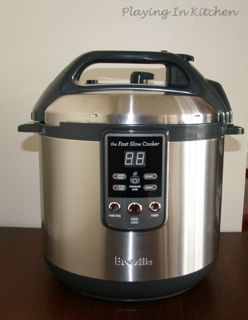
Pressure cookers have been a staple in kitchens all over the world for years, and for an excellent reason. They offer a practical and reliable means to prepare tasty meals in a fraction of the moment it would take with traditional food preparation techniques. Whether you're an experienced chef or a beginner in the kitchen, this utmost guide to using a pressure cooker will aid you open its full possibility and revolutionize your cooking experience.
Prior to diving into the globe of pressure food preparation, it's vital to recognize how these cooking area home appliances function. Pressure cookers deal with a straightforward principle: they produce a covered environment in which pressure develops, elevating the boiling point of water and permitting food to cook much faster. Right here's a breakdown of the vital components:
Cover: The pressure cooker's cover locks securely in place, guaranteeing a limited seal.
Safety and security Valve: The safety valve releases excess pressure to stop crashes.
Pressure Regulator: This tool keeps the desired pressure level throughout cooking.
Gasket (Sealing Ring): A rubber or silicone ring that seals the cooker's cover to the pot.
Pressure Indicator: An aesthetic indicator that shows when the cooker is under pressure.
There are 2 main kinds of pressure cookers: stovetop and electric. Stovetop pressure cookers are placed straight on your oven, while electrical pressure cookers (like the preferred Instant Pot) are standalone devices. When selecting a pressure cooker, consider factors like size, product, and functions. Stainless steel pressure cookers are resilient and withstand staining, making them a prominent option, while aluminum choices are much more affordable.
Security is vital when utilizing a pressure cooker. Comply with these guidelines to guarantee a secure food preparation experience:
Constantly inspect the gasket for damages and guarantee it's correctly seated before usage.
Do not overfill the cooker; there need to suffice space for food to expand.
Never ever open the lid while the cooker is under pressure; await the pressure to launch naturally or use the quick-release shutoff.
Keep the pressure cooker's safety shutoff and heavy steam vent tidy and without obstructions.
Usage care when dealing with hot vapor, and prevent placing your face or hands near the vapor vent.
Pressure cooking can be frightening in the beginning, however with technique, you can end up being a pro. Right here are some essential methods to assist you start:
Sautéing: Many pressure cookers have a sauté function, permitting you to brownish meat and sauté vegetables straight in the pot before pressure cooking.
Fluid Ratio: Use the correct amount of liquid; typically, at the very least 1 mug of liquid is needed for pressure food preparation.
Layering Ingredients: Layering ingredients with thick items on the base and quick-cooking products on top guarantees even cooking.
Changing Cooking Time: Different foods require various cooking times. Refer to a pressure cookers pressure cooking chart for support or follow your recipe.
Natural and Quick Release: Understand when to make use of natural launch (allowing the pressure to go down on its own) or fast release (utilizing the pressure launch valve) based upon your dish.
Pressure cookers run at various pressure degrees, generally determined in pounds per square inch (psi). The majority of recipes are made for either reduced pressure (around 8-10 psi) or high pressure (around 12-15 psi). Food preparation times differ accordingly. Right here are some basic standards:
High Pressure: Ideal for most recipes, decreasing cooking times by 30-50%.
Reduced Pressure: Suitable for delicate foods like fish and specific veggies.
Readjusting Time: As a rule of thumb, for each 1,000 feet above water level, increase cooking time by 5% when utilizing a pressure cooker.
To ensure the long life, safety and security, and optimum performance of your pressure cooker, it's vital to adhere to correct care and upkeep treatments. Below are some handy pointers to maintain in mind:
Tidy the cooker extensively after each usage to prevent food residue accumulation.
Remove and wash the gasket, security valve, and steam vent after every use.
Check the security shutoff and pressure indication for obstructions or damages.
Shop the pressure cooker with the lid upside down to allow air flow.
Replace the gasket regularly to preserve a closed seal.
Now that you've grasped the basics, it's time to explore some delicious pressure cooker recipes. Here are a couple of to obtain you began:
Beef Stew: A timeless comfort food made rapidly and tenderly in the pressure cooker.
Poultry Curry: Create a tasty and fragrant curry in a portion of the moment.
Risotto: Achieve a velvety and dreamy risotto without constant stirring.
Chili: Whip up a passionate and hot bowl of chili quickly.
Verdict
The pressure cooker is a functional kitchen tool that can change the method you cook. By comprehending its basics, exercising crucial strategies, and complying with safety standards, you can open the complete possibility of this home appliance. With a little bit of trial and error, you'll find that the pressure cooker is not just a time-saver yet also a game-changer worldwide of cooking delights. So, do not hesitate to check out new dishes and delight in the convenience and taste that pressure cooking needs to provide. Happy food preparation!